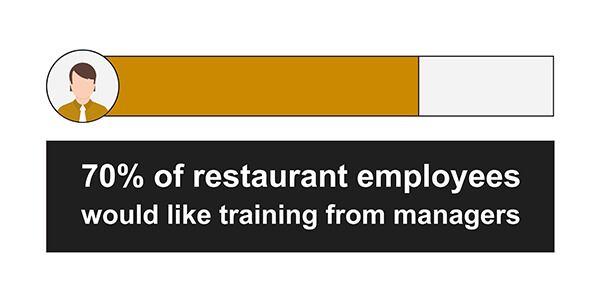June 21, 2021

As restaurants are once again opening their doors, many restaurant owners and managers are finding it challenging to recruit staff. Establishments are competing with unemployment payments, which are sometimes higher than workers’ wages. Plus, new found scheduling conflicts due to the pandemic are making it difficult for employee flexibility.
However, there are some tried and true ways to make it through staffing issues and secure superb staff for years to come. Our restaurant supply store shares best practices for creating a solid staffing plan below.

7 Effective Ways to Recruit and Retain Restaurant Staff
If there is one thing that can be said about the restaurant industry, it’s that it can adapt to change and roll with the punches. While this current staffing plight may seem unmanageable, with some savvy hiring techniques and changes to some day-to-day practices, you can mitigate hiring issues.
1. Revisit Your Restaurant’s Job Descriptions
Positions in the restaurant industry are never static. Service styles change and technology evolves. However, restaurant managers may not update their job descriptions as frequently as they should to keep up with the changing times. Accurate explanations of general employee duties and expectations are essential to attracting the most qualified applicants to your establishment. Review your current job requirements and update them to reflect the present state of your operations.
2. Think Outside of the Box for Job Postings
When advertising for open positions, managers want to ensure they are reaching a large pool of applicants. They also want to reach potential employees that will be an asset to the restaurant. Consider posting available jobs on your website, utilizing local job boards, or reaching out to other restaurant owners who may have leads on talent. Developing an employee referral program is also a great way to encourage current employees to bring in people they trust.
3. Invest Time in Comprehensive Training
Training your workforce shouldn’t begin and end on their first few shifts. Training should be an ongoing process that involves both new hires and current employees. Revisiting protocols, recipes, purchasing budgets for bulk foods, customer service aspects, and day-to-day duties are important for maintaining high standards. Plus, when an employee better understands their manager’s expectations, it can help the worker succeed.
4. Be Willing to Work with an Employee’s Schedule
Due to the effects of the pandemic, more people have to stay home to care for older loved ones and assist in remote learning for their children. For example, in 2020, 93% of homes with school-aged children engaged in some form of distance learning. As a result, people might have a little less flexibility in their schedules.

Book interviews that work with a potential employee’s schedule. Check in with your current staff and start a conversation about their desired hours and current availability. Being willing to adjust shifts could mean retaining a qualified employee over losing them to scheduling conflicts.
5. Create a Supportive and Appreciative Work Environment
Restaurant managers are fully aware of high turnover rates in the industry. Pre-pandemic, the food industry saw about a 75 percent turnover rate. In 2020, that number escalated to over 130 percent. Not only is it time consuming to find, hire, and train members of a crew, it’s costly.

Showing appreciation can go a long way to keeping your team happy and on your books. Listen to the individual needs of your employees and develop perks that work for your budget. Consider options like extra vacation days, gift cards, staff meals, and reducing double shifts.
6. Cross-Train Your Current Staff
Create a plan to cross-train your current and future employees in other roles. Have servers learn bartending or hosting skills or train a prep cook on expediting. Having a workforce that can excel in multiple areas means more hours and growth opportunities for them as well as additional coverage for managers.
7. Utilize Technology to Fill In Gaps
Technology is a must nowadays for restaurant operations, especially during labor shortages. Some apps can help manage everything from online orders to seating to inventory management, relieving some pressure on staff. More advanced systems like self-ordering kiosks and tableside payment options can allow owners to run with fewer front of house crew members.
Restaurant Supplies and Business Resources from US Foods CHEF’STORE
At CHEF’STORE, we pride ourselves on supporting our restaurant partners. We offer high-quality wholesale bulk food for restaurants as well as a variety of business tools, like staffing services. You can also sign up for our customer card for even more industry perks. Visit one of our many locations near you or take advantage of our third-party delivery options!